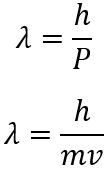Atomic Structure
The basic structure of an atom is defined as the component-level of atomic structure of an atom. Precisely speaking an atom consists of three major subatomic particles which are protons, neutrons, and electrons. Many theories have been stated for explaining the structure of an atom.
Shape of the D Orbital
Shapes of orbitals are an approximate representation of boundaries in space for finding electrons occupied in that respective orbital. D orbitals are known to have a clover leaf shape or dumbbell inside where electrons can be found.
Calculate the de Brogile wavelength of a proton travelig at 3.89 x 10^8 m/s if the mass of the hydrogen molecule is 1.67 x 10^-24 g.
The de Broglie hypothesis:
De Broglie proposed that just as light has both wave-like and particle-like properties, electrons and all other particles also have wave-like properties. The relationship between the wavelength, λ, associated with a particle and its momentum, p is given by:

Where ? = wavelength of the particle =?
h = Plank constant = 6.626×10-34 J.s
P = momentum of the particles
m = mass of the particle = 1.67 x 10^-24 g.
V = velocity of the particle = 3.89 x 10^8 m/s
Step by step
Solved in 3 steps with 2 images









